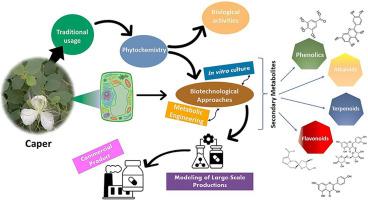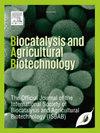Capparis spinosa:酚类化合物的丰富来源 - 植物化学、健康益处和生物技术应用综述
IF 3.4
Q2 BIOTECHNOLOGY & APPLIED MICROBIOLOGY
引用次数: 0
摘要
锥栗(Capparis spinosa)是地中海地区一种具有重要社会经济意义的植物,传统上用于防治各种代谢性疾病。事实上,它的药用价值早已得到认可,这主要归功于其丰富的营养成分以及酚类化合物和其他次生代谢物所产生的强大抗氧化活性。然而,相关次生代谢物的商业化生产需要创新的方法来改善这些代谢物的生物合成,以满足工业需求并缓解自然资源的过度开发。为此,可采用细胞悬浮培养、毛细根培养、生物和非生物诱导剂供应以及基因工程等不同技术来提高辣椒次生代谢物的产量。此外,包括基因组学、转录组学、代谢组学和蛋白质组学在内的全量学工具也有助于阐明生物合成途径和改变目标代谢物的生产。这篇综述首先强调了毛果的植物化学、民族药理学用途和生物活性,同时还讨论了体外培养系统、全局组学工具和代谢工程方法对提高毛果衍生生物活性化合物产量的重要意义。本文章由计算机程序翻译,如有差异,请以英文原文为准。

Capparis spinosa: A rich source of phenolic compounds - A comprehensive review of its phytochemistry, health benefits, and biotechnological applications
Caper (Capparis spinosa) is a plant of significant socio-economic importance in the Mediterranean region which is traditionally used to fight various metabolic diseases. It has indeed long been recognized for its medicinal properties, notably attributed to its rich nutritional content and potent antioxidant activity due to phenolic compounds and other secondary metabolites. However, the commercial production of relevant secondary metabolites requires innovative approaches improving the biosynthesis of these metabolites to fulfill the industrial demand and mitigate the overexploitation of natural resources. For this end, different techniques such as cell suspension culture, hairy roots culture, biotic and abiotic elicitors supply as well as genetic engineering could be used to enhance the production of caper-derived secondary metabolites. In addition, omics tools including genomics, transcriptomics, metabolomics and proteomics can help to elucidate the biosynthetic pathway and altering the production of targeted metabolites. While this review first highlights the phytochemistry, ethno-pharmacological uses, and biological activities of caper, it also discusses the significance of in vitro culture systems, omics tools and metabolic engineering approaches to improve the production of caper-derived bioactive compounds.
求助全文
通过发布文献求助,成功后即可免费获取论文全文。
去求助
来源期刊

Biocatalysis and agricultural biotechnology
Agricultural and Biological Sciences-Agronomy and Crop Science
CiteScore
7.70
自引率
2.50%
发文量
308
审稿时长
48 days
期刊介绍:
Biocatalysis and Agricultural Biotechnology is the official journal of the International Society of Biocatalysis and Agricultural Biotechnology (ISBAB). The journal publishes high quality articles especially in the science and technology of biocatalysis, bioprocesses, agricultural biotechnology, biomedical biotechnology, and, if appropriate, from other related areas of biotechnology. The journal will publish peer-reviewed basic and applied research papers, authoritative reviews, and feature articles. The scope of the journal encompasses the research, industrial, and commercial aspects of biotechnology, including the areas of: biocatalysis; bioprocesses; food and agriculture; genetic engineering; molecular biology; healthcare and pharmaceuticals; biofuels; genomics; nanotechnology; environment and biodiversity; and bioremediation.
 求助内容:
求助内容: 应助结果提醒方式:
应助结果提醒方式:


